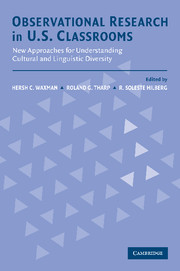 Observational Research in U.S. Classrooms
Observational Research in U.S. Classrooms Published online by Cambridge University Press: 23 November 2009
The goal of this chapter is to discuss a methodology for conducting classroom observations in culturally and linguistically diverse schools implementing externally developed reform designs. The classroom observation strategy discussed in this chapter was developed for a study entitled Scaling Up School Restructuring in Multicultural, Multilingual Contexts. In this study, we conducted longitudinal case studies of 13 elementary schools in Sunland County Public Schools (SCPS), each of which was implementing one or more nationally regarded school reform designs.
Assessments of such reform models have become particularly important as the number of schools implementing these models has increased dramatically in the past few years. The passage of the Obey–Porter law, a bipartisan initiative that allocated 150 million federal dollars in the fall of 1998 (and additional funds in subsequent years) to schools willing to adopt research-based reform programs, is evidence of the growing enthusiasm for external models. This was spurred in part by research suggesting that scaling up externally developed school reform models or promising programs may be the best way to systematically raise students' academic achievement (Stringfield et al., 1997).
However, we know little about how these reforms can be implemented successfully in districts serving linguistically and culturally diverse student populations. Many externally developed school reform models were developed mindful of schools serving students who speak English as a first language. None of the models was developed specifically for multicultural, multilingual student populations.
To save this book to your Kindle, first ensure [email protected] is added to your Approved Personal Document E-mail List under your Personal Document Settings on the Manage Your Content and Devices page of your Amazon account. Then enter the ‘name’ part of your Kindle email address below. Find out more about saving to your Kindle.
Note you can select to save to either the @free.kindle.com or @kindle.com variations. ‘@free.kindle.com’ emails are free but can only be saved to your device when it is connected to wi-fi. ‘@kindle.com’ emails can be delivered even when you are not connected to wi-fi, but note that service fees apply.
Find out more about the Kindle Personal Document Service.
To save content items to your account, please confirm that you agree to abide by our usage policies. If this is the first time you use this feature, you will be asked to authorise Cambridge Core to connect with your account. Find out more about saving content to Dropbox.
To save content items to your account, please confirm that you agree to abide by our usage policies. If this is the first time you use this feature, you will be asked to authorise Cambridge Core to connect with your account. Find out more about saving content to Google Drive.